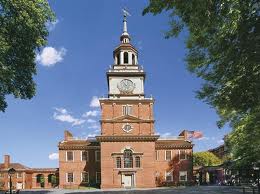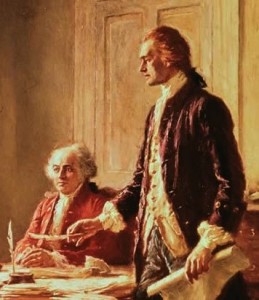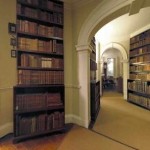 The celebration of American Independence Day on the Fourth of July has come to include parades, barbecues and fireworks. The celebrations should include discussions of how the Declaration of Independence came to be. The story began in Part One as The Committee of Five appointed to draft a declaration of independence had dwindled in reality to just Thomas Jefferson and John Adams, since most members of Congress thought that drafting the declaration was necessary, but not really important. Part Two has Jefferson and Adams agree the declaration’s form. Part Three explores Jefferson’s state of mind following his meeting with Adams, as Jefferson himself is more concerned with events in Virginia than an independence declaration. In Part Four, Jefferson’s selection to draft the declaration takes place.
The celebration of American Independence Day on the Fourth of July has come to include parades, barbecues and fireworks. The celebrations should include discussions of how the Declaration of Independence came to be. The story began in Part One as The Committee of Five appointed to draft a declaration of independence had dwindled in reality to just Thomas Jefferson and John Adams, since most members of Congress thought that drafting the declaration was necessary, but not really important. Part Two has Jefferson and Adams agree the declaration’s form. Part Three explores Jefferson’s state of mind following his meeting with Adams, as Jefferson himself is more concerned with events in Virginia than an independence declaration. In Part Four, Jefferson’s selection to draft the declaration takes place.
By mid-morning of June 13, 1776 Thomas Jefferson had done all he could to impact the coming constitution of Virginia. He had reviewed his proposed constitution to be certain all needed provisions to protect the people’s liberty were included. The first thing this morning he made sure his old mentor, George Wyeth, traveling to Virginia with Richard Henry Lee, would deliver the draft to the Virginia convention. Despite Jefferson’s desire to be in Virginia, he was in Philadelphia and had to tend to his duties in the Continental Congress.
Back to the Business of the Continental Congress
Jefferson arrived at the Pennsylvania State House as President John Hancock called the morning session of the Second Continental Congress to order a little after 10 AM. Though Richard Henry Lee’s resolution on independence was pending, there was other business to be addressed. On this day the Congress would add to John Adams’ every increasing committee portfolio with the chairmanship of the Board of War and Ordnance.
Congress would add to John Adams’ every increasing committee portfolio with the chairmanship of the Board of War and Ordnance.
When Jefferson had met with Adams the day before about the independence declaration, they had agreed to follow up today. With the increasing pressures on Adams’ time it was unclear that he and Jefferson would have the chance to talk. At the lunch break, Jefferson saw a group of delegates congregating in the area outside the assembly area.
Jefferson’s height allowed him to look over the group and see the short Adams in the center. Jefferson could not tell if Adams was aware of Jefferson’s presence or if Adams could see past the men around him. Jefferson was about to walk away when Adams looked up sensed the towering presence and gestured for Jefferson to wait. Adams concluded his conversations and the two men greeted each other.
In short order, as Adams was quick to get to a point, they resumed their discussion of the independence declaration.
Who will Draft the Declaration?
Adams began: “In the midst of everything I tracked down Sherman, Livingston and Franklin. I’ve told them of our conversation regarding the structure of the declaration. They are agreed with the general articles that should be included and approach we discussed.”
Though Jefferson was keenly aware of Adams’ ever increasing responsibilities, he again thought it proper to defer to the older man, “Then you will no doubt work from those points and begin a draft of the declaration.”
Adams, also conscious of his own work load, was a master at delegation. He had prepared a reply to Jefferson’s suggestion: “Thomas, there are many reasons that the drafter should be you and not me. Here are the best five:
- You are a Virginian, and I’m from Massachusetts.
- You are a southern man and I am a northerner.
- The obnoxious nature of my zeal in promoting independence would cause any draft of mine to undergo great scrutiny and criticism from Congress that a draft from you would not receive.
- Though I have yet to hear you utter three sentences in a single instance during sessions in congress, I have a great opinion of the elegance of your pen and little of the elegance of my own pen.
- Finally and most importantly, you can write ten times better than I can.”
Jefferson paused at the lavish praise Adams had just conferred upon him. While flattered, several thoughts crossed his mind. Richard Henry Lee, sponsor of the independency resolution had just left for Virginia. The sponsor’s participation at this point would be customary, but Lee had left town to care for his ailing wife. Roger Sherman had also been selected for the Board of War and Ordnance. Sherman’s priorities did not include writing an independence declaration. Roger Livingston’s presence on the declaration committee had been an effort to compliment New York. Dr. Franklin was in pain every day. Drafting the declaration was not a particularly sought after assignment and it was now falling upon Jefferson.
Smiling inwardly to himself since he understood the purpose of Adams’ unrestrained compliments, Jefferson replied with a bit of understatement, “Well, if you are decided I will do as well as I can.”
Setting Priorities for the Declaration
Following Jefferson’s acceptance, the men reviewed the declaration’s format that they discussed the day before. This review included the necessary points for each audience for the document. The leadership and citizens of the wavering colonies were the most important audience. Without their votes there would be no independence.
The Continental Army and potential recruits were just as crucial. Jefferson and Adams had no illusions that King George and Parliament would read the declaration with approval. The declaration would need to inspire the sacrifice of blood and treasure to turn its words into reality.
The declaration would need to reflect the beliefs that Americans felt in their hearts. This document was not to “convince” Americans of the justness of independence, but rather give expression to the thinking in their minds. The goal, as Adams put it, was to take agreed upon American principles and “cloath them in a proper Dress”.
Upon completing the review, Adams concluded the discussion, “Very well, when you have drawn it up we will have a meeting.”
The Act of Inventing: A Thought Process for a Chair or a Country
 Though Congress would have an afternoon session, Jefferson returned to Graff house to consider the declaration. Once in his apartment with quill and parchment he wrote an outline. With that complete he turned in his chair and looked out the window. He took pleasure in considering his unique chair, his invention with window casters allowing the seat to “swivel” on the base. He smiled realizing that the thinking required to create a chair differed little from needed to create a country.
Though Congress would have an afternoon session, Jefferson returned to Graff house to consider the declaration. Once in his apartment with quill and parchment he wrote an outline. With that complete he turned in his chair and looked out the window. He took pleasure in considering his unique chair, his invention with window casters allowing the seat to “swivel” on the base. He smiled realizing that the thinking required to create a chair differed little from needed to create a country.
He was sitting in a distinctively American chair, about to embark upon the creation of a distinctively American declaration. Though the goal was to capture American ideas, he remembered yesterday’s conversation with Adams and the mental note he’d made of historical precedents that may have a connection to this American declaration.
Jefferson wished he had access to his Monticello library. In leaving Monticello for his journey to Philadelphia, Jefferson had not anticipated the assignment of drafting a declaration defending independence. Though his library contained books by many great thinkers and historical writings he had brought “neither book nor pamphlet” related to such an undertaking. He did have available yesterday’s Philadelphia Gazette that had published George Mason’s proposed Virginia Declaration of Rights.
His wish to be in Virginia returned for a moment, but it was time to turn to working on his assignment, a declaration to explain the reasons for American independence. He relaxed a bit with his violin to clear his mind and then began with notes on the historical analogies.
Continued in Birthing of the Declaration of Independence: Part Five, Historical Precedents






[…] as Jefferson himself is more concerned with events in Virginia than an independence declaration. In Part Four, Jefferson’s selection to draft the declaration takes place. In Part Five, Jefferson considers […]